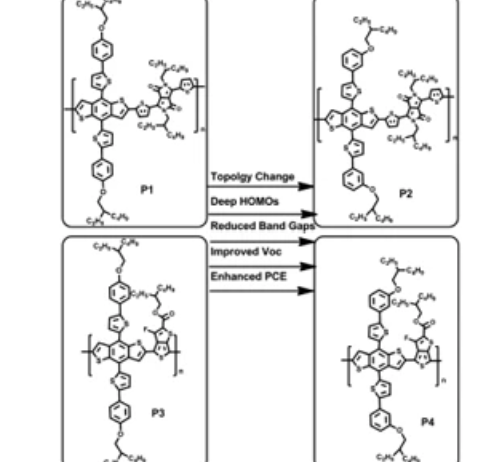Impact of Topology of Alkoxy Side Chain in Alkoxyphenylthiophene Subsituted Benzodithiophene Based 2D Conjugated Low Bandgap Polymers on Photophysical and Photovoltaic Properties
- 저자
- Kakaraparthi Kranthiraja, Ho-Yeol Park, Kumarasamy Gunasekar, Won-Tae Park, Yong-Young Noh, Yeong-Soon Gal, Jong Hun Moon, Jin Yong Lee*, Sung-Ho Jin*
- 저널명
- Macromolecular Research, 26, 500-505 (2018)
- 년도
- 2018
[Abstract]
We report a new series of low band gap (LBG) polymers (P1-P4), in which para or meta- alkoxyphenylthiophene (APTh) substituted benzodithiophene and 2,5-ethylhexyl-3,6-bis(5-bromothiophen-2-yl)pyrrolo[3,4-c]-pyrrole-1,4-dione or 2-ethylhexyl-4,6-dibromo-3-fluorothieno[3,4-b]thiophene-2-carboxylate are key repeating units. All the polymers showed broad absorption profiles over 900 nm with reduced optical band gaps (E g opt). Interestingly, the straightforward modification (exchanging the topology of alkoxy side chain on phenyl group of APTh in donor unit) brought considerable changes in photophysical and photovoltaic properties of new polymers. In particular, meta-substituted polymers (P2, P4) showed reduced E g opt (1.26, 1.41 eV), deep highest occupied molecular orbitals (HOMOs) (-5.23, -5.28 eV) than para-substituted polymers P1, P3 (E g opt=1.33, 1.44 eV; HOMOs=-5.19, -5.20 eV). Furthermore, the optimized P2 and P4 based devices delivered an enhanced power conversion efficiency (PCE) of 4.39 and 4.33%, with open-circuit voltage (V oc ) of 0.71 and 0.79 V, respectively, which are higher than P1 (PCE of 2.95 with V oc of 0.65) and P3 (PCE of 2.33% with V oc of 0.69 V) based devices.
